|
The Captive Dolphin Habitat
A habitat for captive dolphins is a very unique environment,
with very specific requirements.
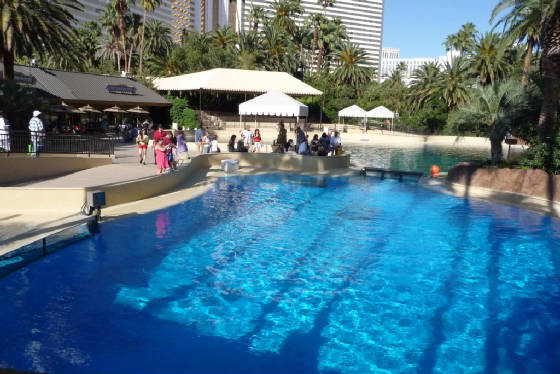
It must be designed to be accessible to the public, viewable without restricted sight lines, yet safe for the habitat's resident
dolphins, its employees and its guests. In addition, it must house its complex environmental maintenance systems, administrative
offices, water filtration and treatment plants, and laboratory facilities for veterinary health assessment and treatment.
Allowances in the design of any dolphin habitat must be made for the separation of animals for social and
breeding purposes. Such separation is often provided by a series of water pressure operated gates.
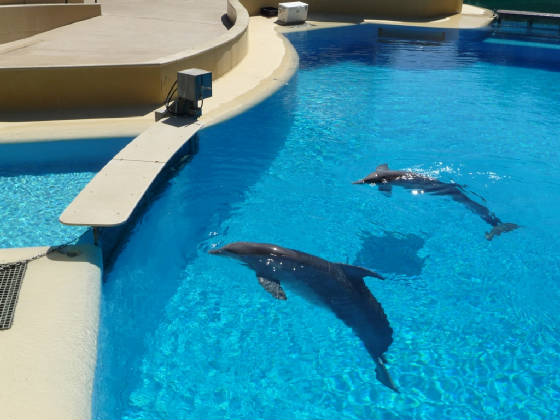
These gates remain secured until which time they are opened to allow passage of dolphins from one habitat
pool to another. Dolphins are often seen up near these gates. This behavior may be for a number of reasons. Animals in one
pool are aware of animals in another pool and being close to the gate leading to that other pool provides the best chance
of communicating and interacting with their captive neighbors. Also, they may prefer to "hang out" in a safe, confining
area which provides a sense of protection from risk. Finally, some captive dolphins will use these "safe havens" as a place
in which to sleep. Dolphins have a natural aversion to passing through restrictive openings, such as gates in a captive habitat.
It may take a period of time for a dolphin held in captivity its whole life and then introduced to a new habitat environment
to learn to be "gated" (directed to pass through a gate from one pool to another).
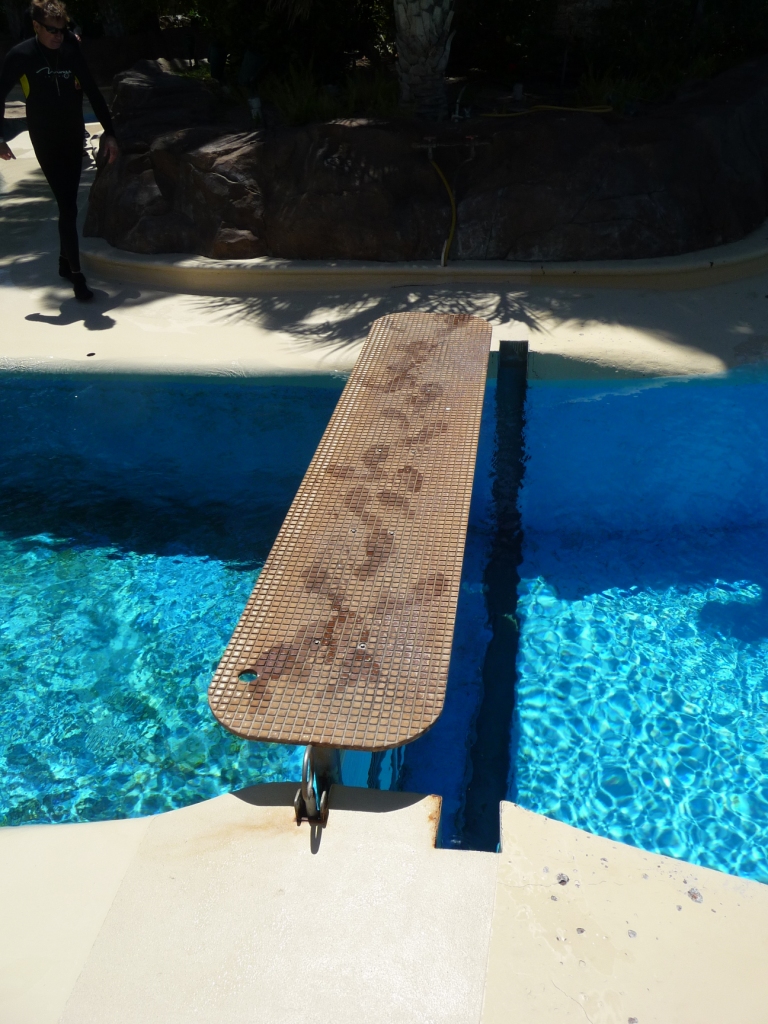
Not only are captive pools separated by gates, "slots" are built into the pool walls so that solid walls
may be inserted to seal off each separate pool. This procedure would be necessary if an individual pool required maintenance
(e.g. draining) without affecting other pools in the captive habitat.
Bottlenose dolphins can reach speeds
approaching 22 MPH and leap 20 feet in the air. So why don't captive dolphins jump over these gates? Dolphins do not
possess a natural instinct to jump over objects, as this behavior would not typically be required in the wild. Also,
the animal's echolocation system identifies a semi-solid object (the gate we are discussing) in front of the animal. It can
detect the approximate thickness, height, and width of this object. But the echolocation system has difficulty discerning
what lies beyond this object and whether or not it would be safe to jump over the object only to land in an "unknown" area.
Thus, the dolphin stays behind the gate and will only move into another habitat pool when the gate is opened.
To study wild dolphins, researchers
may encircle an animal of interest using a long, deep net having a top which floats only inches above the water. The
researchers then carefully enter the water within this encircled area to measure and briefly study the "captured" dolphin
before letting it swim freely away. Even though this encirclement results in significant stress to the dolphin, very
rarely will an animal in this situation jump over this net to escape this "threat" to its safety.
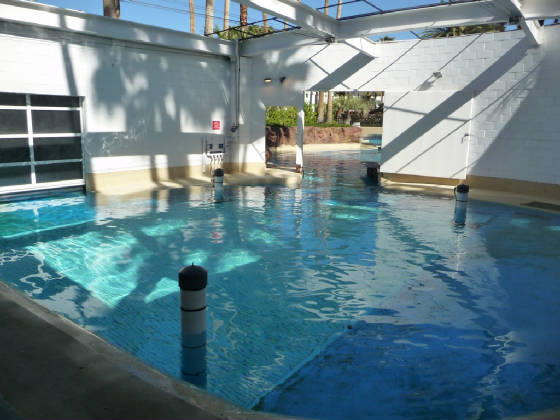
Some captive facilities have pools designed for a specific function. This pool serves as an "isolation" area
in which one or more animals may be isolated for observation or treatment. The floor of this pool may be lifted hydraulically
so that the dolphin may be accessed out of the water for treatment or examination. Protective screening is placed on all four
sides of the floor to protect the animal from inadvertently falling off when being lifted above the water. An adjustable curtain
is used to cover this pool on hot sunny days. Solid doors are provided to close off the area from public view should a particular procedure
or treatment be required.
The general health and survival of captive
dolphins is highly dependent upon the control of water quality in the captive habitat. Marine systems require the
manufacture of salt water (unless a nearby source of filtered ocean water is available) using commercially available products
such as Instant Ocean. Initially, salt is added to fresh water to bring the specific gravity of the pool water to approximately
1.800 units. Through frequent vacuuming of pool bottoms and the backwashing of sand filters, acceptable and legal volumes
of some salt water are disposed of into the sewer system. This disposal removes salt from the pool. Subsequent natural rainfall
then dilutes the salt concentration and thus reduces the specific gravity of the pool requiring an occasional addition
of salt to the system. The pH, salinity, water temperature and volume of water must be constantly monitored.
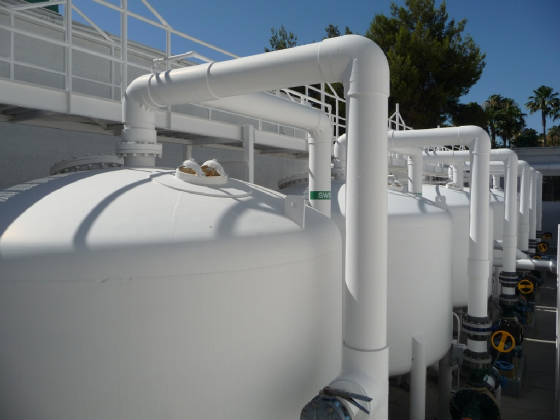
The primary method of water maintenance
in a captive dolphin environment is sand filtration. The sand filters seen in this photograph are just larger versions of
ones commonly used on home swimming pools. Sand of larger and larger grain size is layered within each filter housing. Water
from the habitat is pumped into the filters in a downward flow. Sand grains are cubical and function to hold back undesirable
particulate from the habitat water as it passes downward through these layers of smaller and smaller grains. As the volume
of unwanted particulate increases over time within each filter, a pressure gauge indicates it is time to "backwash" the sand.
Reversing the flow of water through these filters removes the collected particulate. It is sent to a recovery tank where it
is separated from the habitat water. The particulate is discarded and the recovered clean water is returned to the habitat
pools. After many years of use, the sand grains will begin to lose their cubical shape and become rounded. Rounded sand grains
do not effectively retain particulate and will need replacement.
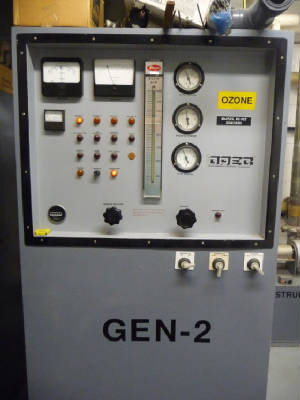
In addition to sand filtration, injecting ozone into the water is used as an agent for the
control of microorganisms (such as bacteria). The use of ozone to kill microorganisms is 3,000 times more effective than
chlorination. Here is a typical ozone generator used in a marine facility. Ozone generators have been used in home marine
aquariums for years and are being used more and more commonly in residential swimming pools as a means of water treatment.
Ozone generation
sounds complex, but let's look at an explanation of its use.
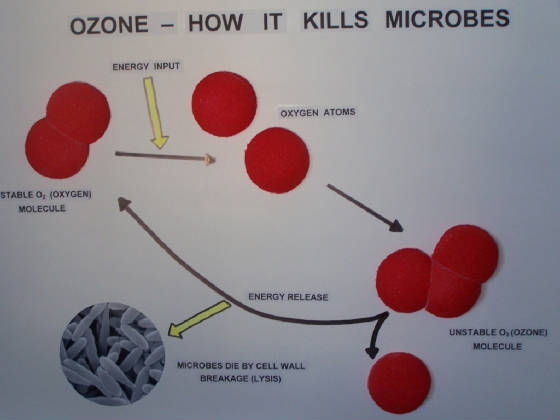
Ozone (O3) is a
molecule of oxygen (O2) with one additional oxygen atom (O) added. To accomplish this, a high voltage
electric current is passed through a stream of air (air consists of 20% oxygen molecules). In this process, each O2
molecule is broken up into two individual atoms of oxygen. Three of these oxygen atoms then briefly combine to form ozone
(O3). The ozone molecule is very unstable, as this is not the way in which oxygen atoms typically exist
as molecules in nature. The ozone generated at a captive dolphin habitat is then bubbled into the water. Because of their
instability, the ozone (O3) molecules quickly begin to revert back to oxygen (O2)
releasing not only the extra oxygen atom, but a very tiny burst of electrical energy as each oxygen bond is broken. Billions
of these "electrical bursts" combine in the habitat water to kill bacteria by lysing (breaking) the bacterial cell walls. Then,
the resulting, harmless O2 is released to the atmosphere.
As a further means of water treatment, very
low levels of chlorine are added to habitat water.
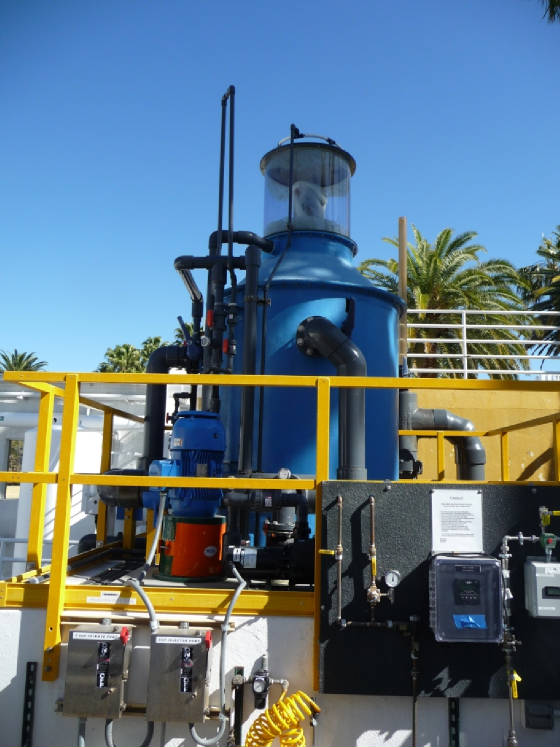
Protein skimming, also called foam fractionation, may be used to further clarify the marine
water system. Protein skimmers are large tanks into which pool water continuously flows into the top of the skimmer and out
of the bottom of the unit.
A high volume of air is injected into the bottom the skimmer. As the mass of tiny air
bubbles move upward against the downward flow of pool water, organic wastes produced by the captive dolphin population
stick to the air bubbles and come to the surface as a "foam".
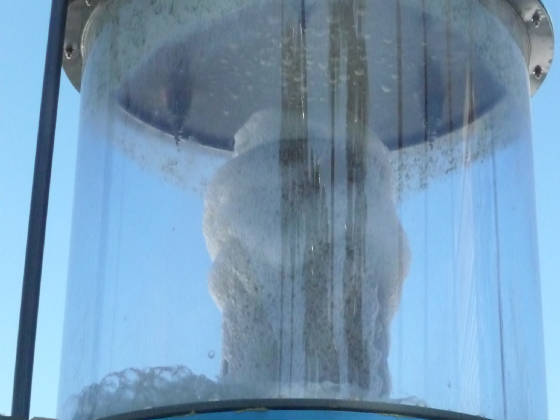
This foam of organic waste bubbles up and out of an opening at the top of the skimmer, is trapped and discarded.
Perhaps you have driven along the shoreline of an ocean or large inland lake and have observed
a brownish foam rolling up onto the beach. This is the ocean or lake naturally protein skimming organic wastes from the
water.
Captive dolphin habitats utilize complex computer systems to monitor water levels,
sand filtration, water recovery, salt concentration, ORP (oxygen reduction potential - the effectiveness of the ozone treatment
process), water temperature, chlorine levels, pH (acidity or alkalinity levels), etc. A staff of highly trained "life support"
engineers are responsible for monitoring these computer systems and responding as required.
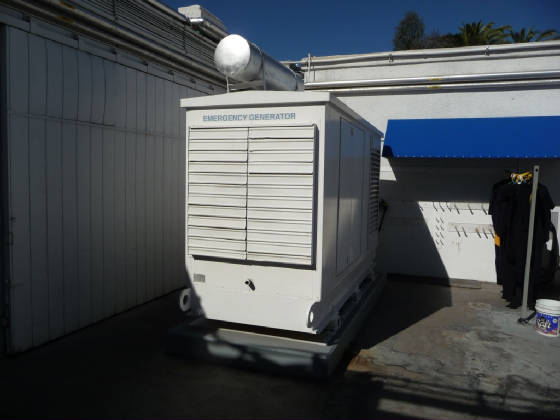
The availability of an emergency generator
is necessary should power to the captive habitat be interrupted. In most cases the emergency generator utilizes diesel fuel
to operate.
Generators, such as the one pictured here, have
the capacity to keep the vital filtration, water treatment and electrical systems functioning until power can be restored.
The water in a captive marine environment is generally kept at a fairly constant temperature. This is done so
that animal diet may be managed more easily and not require major adjustments throughout the year as seasonal temperatures
fluctuate.
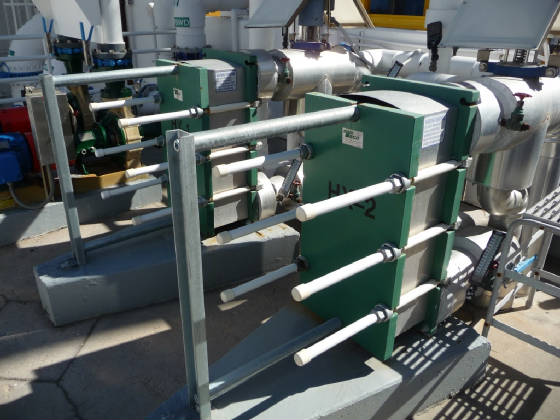
Water temperature is heated and cooled using heat exchangers such as these.
A series of titanium plates inside each heat exchanger is heated or cooled, depending on the time of the year.
As the marine habitat water is passed into the exchangers and across these plates, the water is heated or cooled by
this process and then returned to the habitat pool at a constant 70 to 73 degrees F no mater what the external air temperature
is (from freezing to well over 100 degrees F).
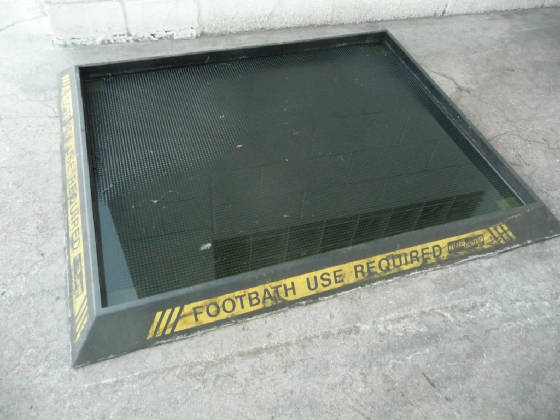
Throughout the captive habitat care must be taken to avoid carrying contamination from one area to another. Contamination
is commonly carried on feet and shoes so footbaths of disinfectant are provided. Habitat employees must step in these footbaths
as they move about the facility.
There are certain contaminants which are not removed by the standard filtration processes in captive habitats,
but are an ever-present concern to the health of marine mammals. One of these is called "perchlorate". Perchlorate
is a man-made organic contaminant that enters the water from airborne wastes resulting from rocket and jet fuel combustion
and the manufacture and explosion of fireworks. Perchlorate has been shown to negatively affect thyroid gland function. It
is toxic at very low levels, is widespread in the environment and is appearing in ecosystems around the world. Captive habitats
can concentrate perchlorate over time and water changes become necessary to keep these levels below a toxic threshold. The
oceans are exposed to perchlorate as well, but at this time the vast volume of ocean water has the ability to dilute these
chemicals, reducing their toxic effect. Yet, in areas where rocket fuel is being used (e.g. off the northeastern Florida coast)
and where commercial airplanes frequently pass (high traffic ocean flight patterns and dolphin habitats near airports) this
can be a threat to the safety of these animals. The latest studies have shown waterborne perchlorate levels to be highest
in the states of California, Nevada, Utah, Arizona, Texas, Arkansas, Alabama and West Virginia. Additionally, Oregon and Missouri
have relatively high levels of perchlorate in their water. The EPA has now established acceptable limits on the levels of
perchlorate in water. This was done to help protect human drinking water, but may serve to provide some level of protection
for both captive and wild marine mammals.
Site Content
Understanddolphins.com contains information condensed from a number of reputable technical sources,
peer reviewed journal articles, and respected dolphin research facilities, as well as from my personal experiences and
observations as a dolphin VIP Tour Guide and Educator.
I have made every attempt to support the information presented in this site with video and still
photographic images. On a regular basis I plan to produce more of these images and will continue to update the site with these
as well as with any new and scientifically verified information which becomes available.
|



